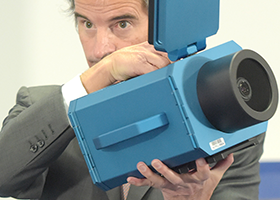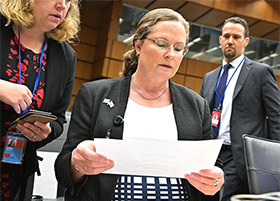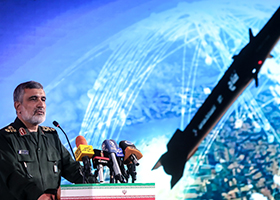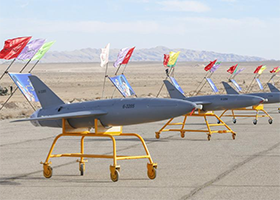Recent comments from U.S. and Iranian officials suggest that the space for negotiations over Iran’s nuclear program may be opening back up after talks broke down in August, but the two sides denied recent reports that an interim nuclear deal is on the table.
Iranian Foreign Ministry spokesperson Nasser Kanaani confirmed a June 9 Axios report that the United States and Iran held indirect talks in Oman in May. Kanaani told reporters that Iran conveyed messages to the United States regarding the lifting of sanctions. He also said Tehran remains focused on restoring the 2015 nuclear deal, known as the Joint Comprehensive Plan of Action (JCPOA), and is not discussing interim arrangements.
State Department spokesperson Vedant Patel also dismissed reports of an interim deal, saying June 9 that such an agreement is “not on the agenda.” The agreement to restore the JCPOA under discussion in August, which Iran prefers, is also off the table for the United States given Iran’s nuclear advances and heightened antipathy toward Tehran for its support for Russia’s war in Ukraine and brutal crackdown on domestic protesters.
However, a senior U.S. official told The Diplomatic June 12 that the Biden administration has made clear to Iran that the United States is “interested in a de-escalatory path” and wants to see if Iran is “prepared to do that.” If Tehran is willing to take steps that demonstrate an openness to “change the current trajectory” that could “open up different possibilities,” the official said.
The Biden administration has also communicated to Iran that certain actions “could lead us to a very dangerous spot,” likely referring to U.S. redlines regarding Iran’s advancing nuclear program, the official said.
While Iranian officials continue to emphasize that Tehran’s focus is on restoring the JCPOA, recent comments from the country’s Supreme Leader, Ayatollah Ali Khamenei, suggest that other diplomatic approaches may be possible.
In a rare visit to the Atomic Energy Organization of Iran (AEOI) June 11, Khamenei said that signing “agreements in some areas” is “not a problem” so long as the country’s nuclear infrastructure remains intact and the agreements respect a December 2020 nuclear law. The law lays out certain requirements for the AEOI to advance Iran’s nuclear program absent sanctions relief.
It is not clear what Khamenei means by saying Iran’s “nuclear infrastructure must not be changed.” Since Iran began violating the JCPOA in response to the U.S. withdrawal from the deal and reimposition of sanctions, Iran significantly expanded its nuclear program. During negotiations on the JPCOA, the Iranian team pressed to retain all of Iran’s nuclear facilities but was open to repurposing certain sites and agreed to dismantle the majority of the country’s centrifuges. The JCPOA, for instance, required Iran to convert the Fordow enrichment plant to a nuclear research facility focused on producing isotopes.
Khamenei reiterated in the June 11 statement that Iran has no interest in pursuing nuclear weapons and that the country’s “Islamic principles” prohibit it. He suggested that the West is focused on stopping Iran’s nuclear program to prevent the country from making “scientific progress.” He said that “if Iran wanted to build nuclear weapons, we would have done so” and the West would not have been able to stop it.
He also recommended that the AEOI maintain “cooperation and communication” with the IAEA “within the framework of the safeguards agreement.” Iran, however, has dragged out an IAEA investigation into past nuclear activities that should have been declared to the agency and still has not provided technically credible answers for the presence of uranium at two of the four sites under investigation (see below for details). Iran also has current safeguards issues that must be addressed. The IAEA noted in its May 31 report that Tehran has not yet clarified a material accountancy discrepancy related to Iran’s work with uranium metal.
The day after Khamenei’s remarks, Iran’s lead negotiator Ali Baqeri-Khani met with political directors from the E3 countries (France, Germany, and the United Kingdom) in Abu Dhabi to discuss several issues, including the nuclear program. A similar meeting took place in Oslo in March.
The Wall Street Journal reported June 14 that Baqeri-Khani also engaged in proximity talks with the United States in Oman in March and discussed the nuclear program. The United States and the E3 are looking for Iran to take steps such as halting accumulation of uranium enriched to 60 percent and the installation of additional advanced centrifuges to deescalate, according to The Wall Street Joural report. Iran seeks the unfreezing of assets held abroad due to U.S. sanctions.--KELSEY DAVENPORT, director for nonproliferation policy
Iran Takes Limited Steps to Increase Monitoring
Iran’s stockpile of highly enriched uranium grew over the last quarter, but the country did take limited steps to increase monitoring of its nuclear program, according to the International Atomic Energy Agency (IAEA).
 The IAEA’s May 31 report on Iran’s nuclear activities noted that Iran’s stockpile of uranium enriched to 60 percent grew from 87 kilograms in February to 114 kilograms in May, enough for almost three nuclear weapons if enriched to weapons-grade levels (90 percent). Iran’s stockpile of uranium enriched to 20 percent grew from 435 kilograms in February to 471 kilograms in May. These stockpiles—particularly the material enriched to 60 percent—pose a more serious proliferation risk because they can be rapidly enriched to weapons-grade levels. If Tehran were to decide to enrich to weapons grade, it could use the 60 and 20 percent enriched material to produce enough 90 percent enriched uranium for five bombs in less than a month.
The IAEA’s May 31 report on Iran’s nuclear activities noted that Iran’s stockpile of uranium enriched to 60 percent grew from 87 kilograms in February to 114 kilograms in May, enough for almost three nuclear weapons if enriched to weapons-grade levels (90 percent). Iran’s stockpile of uranium enriched to 20 percent grew from 435 kilograms in February to 471 kilograms in May. These stockpiles—particularly the material enriched to 60 percent—pose a more serious proliferation risk because they can be rapidly enriched to weapons-grade levels. If Tehran were to decide to enrich to weapons grade, it could use the 60 and 20 percent enriched material to produce enough 90 percent enriched uranium for five bombs in less than a month.
Iran's current need for 20 percent enriched uranium (for the Tehran Research Reactor) is being met by Russia and the country has no justification for enriching uranium to 60 percent. In a June 6 statement to the IAEA’s Board of Governors, France, Germany, and the United Kingdom (E3) called attention to growth in the 60 percent stockpile, describing it as “a major expansion of Iran’s nuclear program, raising serious questions about the intent of its activities.”
While Iran’s stockpile expansion is troubling, the IAEA did note that Tehran took limited steps under a March 4 agreement with the agency to voluntarily increase monitoring of its nuclear program. IAEA Director General Rafael Mariano Grossi acknowledged the progress but told the IAEA Board of Governors June 6 that the actions taken are a “fraction” of what is necessary. He called for an “uninterrupted process” that leads to the March 4 agreement being implemented “without further delay.
Specifically, the IAEA reinstalled cameras at a facility in Esfahan used to manufacture centrifuge components and installed enrichment monitoring devices at the Fordow enrichment plant and the Natanz pilot enrichment plant. Iran is enriching uranium to 60 percent at both facilities.
Grossi said the enrichment monitoring equipment will help the agency “detect more rapidly any variations in enrichment levels at these facilities.”
While the installation of the cameras at Esfahan is also positive, the immediate benefits to the IAEA are limited. The presence of the cameras may deter Iran from diverting materials for undeclared activities but without access to the data the IAEA cannot begin reconstructing a history of Iran’s nuclear activities during the monitoring gap. The May 31 IAEA report made clear that the IAEA does not have access to the current recordings at the Esfahan site or any of the recordings from the February 2021-June 2022 period. Iran agreed to allow cameras to continue surveilling certain sites, including the centrifuge production facility at Esfahan, after it suspended the additional protocol to its safeguards agreement and certain JCPOA-related measures in February 2021 with the understanding Tehran would hand over the recordings to the IAEA if the JCPOA were restored. Iran disconnected those machines in June 2022 and put the recordings under seal.
Grossi said access to the past and current recordings is “indispensable” to the agency’s work to reestablish a baseline of Iran’s nuclear activities and called for an agreement to access the data “without delay.” The IAEA again warned in its report that the gaps in monitoring will make it more difficult, if not impossible, to reestablish reliable baselines for verifying certain limits on Iran’s nuclear program down the road.
The May 31 IAEA report also noted progress on the agency's investigation into uranium particles enriched to 84 percent that the agency found at Fordow in January. The IAEA said Iran provided information about the particles that was “not inconsistent” with Iran’s prior explanations that the spike was inadvertent. The agency says it has no further questions about the incident at this time, but the E3 still expressed concern about the incident.
The E3 said Iran’s continued operation of a centrifuge cascade configuration that produced the particles shows Tehran’s “disregard for the gravity of this development” and that the significance of Iran’s modifications at Fordow “should be fully understood.”
The IAEA report also noted that Iran provided updated design information for the unfinished heavy-water reactor at Arak, also known as the Khondab reactor. According to the information submitted, Iran intended to complete the reactor based on the modified design agreed to in the JCPOA, rather than the original design. This is significant from a nonproliferation perspective because the modified design will produce a fraction of the plutonium necessary for a nuclear weapon on an annual basis, as compared to the two bombs worth of weapons-grade plutonium that would be produced under the original design.
Iran said it plans to commission the reactor in 2023 and bring it online in 2024.
It is unclear from the IAEA’s report if Iran is receiving any assistance with the reactor project. Under the JCPOA, China committed to assisting with the reactor conversion. When the Biden administration renewed waivers for certain nonproliferation projects in 2022, it opened the path for China to resume support for the reactor project without the threat of U.S. sanctions.
Iran Provides “Possible Explanation” for Marivan
The International Atomic Energy Agency reported that Iran provided a “possible explanation” for the presence of uranium at one of the four sites the agency is investigating as part of its probe into undeclared Iranian nuclear activities from the pre-2003 period. The United States, however, suggested that Iran has not provided evidence to back up its claim regarding the origins of the uranium particles detected at the Marivan site.
 Specifically, the IAEA said in a May 31 report that Iran provided a “possible explanation for the presence of depleted uranium particles at Marivan” and that it has “no additional questions” about the location “at this stage.”
Specifically, the IAEA said in a May 31 report that Iran provided a “possible explanation for the presence of depleted uranium particles at Marivan” and that it has “no additional questions” about the location “at this stage.”
The IAEA visited Marivan in August 2020 and took samples at two locations, one of which revealed the presence of uranium, suggesting that Iran’s failure to declare the location to the IAEA is a safeguards violation. In communications with the IAEA in 2021, Iran claimed that a foreign organization running a mine at Marivan was responsible for the uranium contamination. In a May 2022 report, the IAEA said Iran’s explanation was not technically credible. The IAEA also included in that report communications with the “Member State” where the mine operator was located. The “Member State” told the IAEA that Iran provided “no information indicating a link” between the mining operation and the uranium.
According to the most recent report, Iran provided additional information about a chemical laboratory run by the company operating the mine and said that “laboratory instruments and equipment” used by the miners caused the uranium contamination. There was no mention of any follow-up with the “Member State” in the May 2023 report, but the IAEA found the explanation possible.
However, Laura Holgate, U.S. Ambassador to the IAEA, said June 7 during the IAEA Board meeting that Iran has “not provided any evidence to support this explanation.” She said that the file on Marivan is not closed and that “new information or circumstances could prompt further inquiries.”
The IAEA report said Iran did not provide any further information about the second location at Marivan. The agency did not detect uranium at that location when it took samples in 2020, but assesses that Iran conducted explosive testing “in preparation for the use of neutron detectors and nuclear material.”
Iran also did not provide additional information about the other two sites, Varamin and Turquazabad, which remain under investigation. The IAEA said in May 2022 that it had no additional questions about the fourth site, Lavisan Shian, and assessed that Iran conducted activities at that location that should have been declared to the agency.
In a June 5 statement to the IAEA’s Board of Governors, the agency’s Director General Rafael Mariano Grossi said that the remaining safeguards issues “still need to be resolved for the Agency to be in a position to provide assurance that Iran’s nuclear programme is exclusively peaceful.”
The IAEA also said in the report that it is still seeking clarification from Iran regarding a material accounting discrepancy originating from uranium waste and metal products transferred from a lab to Iran’s uranium conversion facility. According to the IAEA, Iran has acknowledged the discrepancy, but the information provided to the agency in April does not satisfy the accountancy requirements in Iran’s safeguards agreement. The IAEA said it requested that Tehran correct the records based on “technically sound measurement results.”
Despite the outstanding questions, Iran’s limited cooperation was enough to prevent the IAEA Board from censuring Iran for failing to address the IAEA’s safeguards inquiries.
France, Germany, and the United Kingdom (E3)said in a June 7 statement that if Iran does not follow through on its obligations before the next board meeting in September, “the Board will have to be prepared to take further action, including if necessary making a finding on whether the Agency is not able to verify that there has been no diversion of nuclear material.”
Specifically, the E3 said Tehran must implement the obligations in the resolution passed by the Board in November 2022 which said it is “essential and urgent” for Iran to clarify “all outstanding safeguards issues….without delay.”
Iran Boasts Hypersonic Missile
Iran displayed a new missile, which the Islamic Revolutionary Guard Corps (IRGC) Aerospace Commander Amir Ali Hajizadeh described as the country’s first indigenously built hypersonic ballistic missile.
 During the unveiling of the missile June 6, Hajizadeh said the system, dubbed the Fattah, is a two-stage, solid-fueled missile and has a range of 1,400 kilometers. No exisiting missile defense system is capable of intercepting it, he said.
During the unveiling of the missile June 6, Hajizadeh said the system, dubbed the Fattah, is a two-stage, solid-fueled missile and has a range of 1,400 kilometers. No exisiting missile defense system is capable of intercepting it, he said.
Hypersonic ballistic missiles travel at such high speeds—at least five times the speed of sound—that they are nearly impossible to intercept.
Iranian President Ebrahim Raisi said the Iran "gained deterrence" with the development of the Fattah and said pressure from Iran's enemies will not inhibit missile development.
UN Security Council Resolution 2231, which endorsed the 2015 nuclear deal and modified UN sanctions on Iran, calls upon Tehran not to develop missiles designed to be nuclear-capable. In addition to the nonbinding nature of the provision, there is a lack of clarity regarding what constitutes “designed” to be nuclear-capable. Nuclear-capable missiles are generally defined as systems capable of carrying a 500 kilogram payload over 300 kilometers. Several Iranian missiles, including the new Fattah, fit into that category, but Iran maintains that the systems are not "designed" to carry nuclear warheads.
The French Foreign Ministry described the new system as “another breach” of Iran’s obligations under Resolution 2231 and raised concern that the development “comes amid the continued escalation of Iran’s nuclear and ballistic missile programs.”
Iranian Foreign Ministry spokesperson Nasser Kanaani rebutted the French statement June 8, saying that Iran’s missile program is “legitimate” and conforms with international law.
US Calls Attention to Iran-Russia Drone Deals
The Biden administration released new information detailing how Tehran is assisting Moscow with the construction of a new factory in Russia designed to produce attack drones.
 Iran’s provision of drones to Russia in violation of international law is well-documented and The Wall Street Journal reported on plans to collaborate on a drone factory earlier this year, but in making the new information public, the Biden administration may be attempting to keep pressure on Iran regarding its support for Russia’s war in Ukraine.
Iran’s provision of drones to Russia in violation of international law is well-documented and The Wall Street Journal reported on plans to collaborate on a drone factory earlier this year, but in making the new information public, the Biden administration may be attempting to keep pressure on Iran regarding its support for Russia’s war in Ukraine.
National Security Council spokesman John Kirby said June 9 Iran is providing materials for the plant and it could be operational in 2024. Kirby said the United States will also be working with businesses to ensure they are not “inadvertently” assisting Iran’s drone activities.
While Iran is prohibited from transferring missiles and drones capable of delivering nuclear weapons and related components to Russia under UN Security Council Resolution 2231, which endorsed the 2015 nuclear deal, it is challenging to track and interdict the illicit shipments.
The prohibition on Iranian missile and drone transfers under Resolution 2231 is set to expire in October.
In Case You Missed It…
- Kelsey Davenport, “An Opening to Deescalate the Iran Nuclear Crisis?,” Just Security, June 13
- Eric Brewer and Henry Rome, Biden’s Iran Gamble: A Risky New Strategy to Keep Iran from Going Nuclear, Foreign Affairs, June 9
- Meir Javedanfar, View from Israel: Could Netanyahu attack Iran’s nuclear program: it’s not so easy, European Leadership Network, May 18
- Ali Vaez and Vali Nasr, The Path to a New Iran Deal: A Regional Agreement Could Succeed Where Washington Failed, Foreign Affairs, May 8
- Jane Darby Menton, What Most People Get Wrong About the Iran Nuclear Deal, Foreign Policy, May 7
